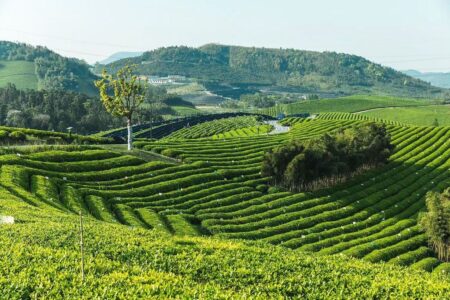The Hidden Power of Coffee Fermentation

Fermentation – the time that pulped coffee spends in a tank before it is dried – is also an opportunity to impact flavour. Microbiologist Lucia Solis, who specializes in microbial demucilagination, explains how this method offers a consistent and predictable coffee fermentation process, reducing the risk of spoilage or defects in the cup.
By Lucia Solis All photos courtesy of Lucia Solis
For the last three years, I’ve worked in beneficios – coffee mills – across Central and South America attempting to shift the paradigm of how coffee is processed. I’ve leveraged my training as a winemaker in Napa Valley, California, as one tool to empower producers who are often very disconnected from the other end of the supply chain — roasters and cafés around the world.
My work as a winemaker, and now as a coffee fermentation designer, hinges on one simple truth: fermentation creates chemical compounds with sensory characteristics. Though we can’t see microbes with the naked eye, we know they influence taste and aroma because we notice their impact when the fermentation goes wrong: we taste this in the form of cup defects, what is often (and erroneously) referred to as “ferment” or “over fermentation.”
Much of my work includes processing practices, focusing on the traditionally neglected step of fermentation to enhance the quality of coffee. Historically, “fermentation” is described as the time that pulped coffee spends in a tank before it is dried. The goal of this step is to remove the mucilage and liberate the seed so that it can be dried, milled and roasted.
Traditionally, “fermentation” is viewed as a process that, if done poorly, could damage and lower the quality of the coffee, and at its very best, merely maintains the inherent quality of the seed. The skin, which serves as a protective boundary for the seed, is removed prior to microbial demucilagination, leaving the coffee vulnerable to spoilage. That is, the traditional paradigm suggests that fermentation offers no opportunity for flavours enhancement, only risk.
Michael Sivetz, whose work influenced coffee from processing through to roasting, wrote: “It has been well established that coffee does not improve as processing time increases especially while the coffee contains large amounts of moisture.”
This places producers in a posture of risk-aversion: processing is a step where the hard work done in the field can be ruined, so we should reduce the total processing time in order to maintain quality. This was really good advice when Sivetz wrote Coffee Processing Technology, but that was nearly 60 years ago and we have learned a lot since then.
More Than a Mechanical Process
Coming from a winemaking background, I am sensitive to comparisons between specialty coffee and wine. The more I learn about coffee, the more differences I see. To me, coffee is not like wine: but it can learn from winemaking and apply principles from the winery to the beneficio.
Both winemaking and coffee processing begin with a fruit that is transformed into beloved beverages. In wine, the skin and pulp become the final beverage. Much care is taken to exclude the seeds as much as possible as they can produce harsh or astringent flavours. Conversely in coffee, the fermentation step is used to remove the fruit pulp and keep the seed.
Wine could not exist without fermentation; coffee can. This step is not necessary to produce coffee; it’s just one way to remove the mucilage, a step that can be completely bypassed by mechanically removing the mucilage using water and friction. Mechanical demucilagination, its proponents note, allows for a consistent and predictable process, reducing the risk of spoilage or defects in the cup.
I believe that “fermentation” is more than a mechanical process. I consider the fermentation step to be the entire period between the cherry being plucked from the tree and dried on a patio or mechanical drier. “Fermentation” is a biological process, a metabolism by which microbes like yeast and bacteria derive energy. As soon as the cherry is harvested, there is opportunity for microbes in the environment to begin to act upon the fruit — they don’t wait until the coffee reaches the tank (there is microbial fermentation activity in honey process and dry process/natural coffees as well!).
Wild yeasts, bacteria and fungi present in the environment – on the cherry skin, in the tank, in the water, and virtually every surface of the mill – break down the sugar and pectin-rich mucilage layer thereby “cleaning” the seed and preparing it for the drying process. This process happens without human intervention. The time it takes the microbes to break down the mucilage varies drastically in time depending on ambient temperature, water temperature and quality, the ripeness of the fruit, cultivar, and whether it is the start or end of the harvest season. Many producers are familiar with these variations but few think about another important variation: the identity of the microbes present at the site.
How a producer chooses to remove the mucilage from the seed can determine whether the flavours produced are desirable or undesirable and influence the resulting coffee. The fermentation step is a powerful opportunity to create flavours. Given enough time, the seed can absorb by-products from the fermentation happening around it. Any flavours produced in the tank could impact the cup.
Therefore, I would like to propose a revision to Michael Sivetz’s statement: “It has been well established that coffee quality will change as processing time increases especially while the coffee contains large amounts of moisture.”
Controlling fermentation is key to unlocking the power of this metabolism and harnessing it to create positive attributes. Fermentation is an opportunity to impact flavours, and all the steps from the farm to the patio can impact the quality (including consistency) of the coffee.
The Benefits of Yeast Inoculation
Farmers deal with many inconsistent, often uncontrollable variables such as rainfall; ambient temperatures; the cost of fertilizer, labour and pesticides; pest and disease pressures; and market prices. One less-obvious variable impacting quality is the microbial population of farms and beneficios.
Instead of relying on the climate and chance to dictate results, producers can actively select the microbes in the tank. This selection empowers producers to participate in the quality of the resulting coffee. The results are predictable and consistent. Active selection of microbes can combine the complexity of flavours and acidity of traditionally washed coffees with the clean consistency of a mechanically washed process. There does not need to be a compromise.
Selecting the microbe population for the coffee fermentation no longer has to be a conversation about mitigating risk or reducing defects — it satisfies these concerns and can turn the focus to increasing value and quality. Industries like wine, beer, distilled spirits, cheese, yogurt have been selecting their microbes to add complexity to their raw material and maintain or enhance quality while reducing risk. Active selection of microbes empowers coffee producers to utilize the same tools that have been available to other industries for decades.
While coffee processing technology provides a great foundation for processing, science and our understanding of processing continues to advance. This level of risk aversion is at odds with the changing market as consumer demand increases for traceable, higher-quality coffees. Many in the supply chain will be left behind if certain processing practices are not critically reviewed and updated.
You can’t keep up with today’s market using last century’s techniques.
Microbiologist Lucia Solis, specializes in microbial demucilagination, or the use of microbes to process coffee following pulping. Born in Guatemala and raised in San Francisco, Lucia studied Viticulture and Enology at UC, Davis prior to working in the wine industry in Napa Valley. In 2014, she started at Scott Laboratories and travelled to Central America applying commercial yeast strains at coffee mills to modulate flavours coming from the tank. Today, she is an independent consultant working directly with coffee producers in origin countries to improve processing practices to increase quality.



